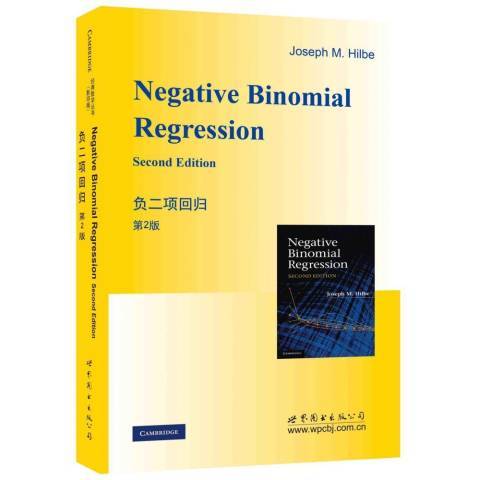《負二項回歸第二版》是2016年世界圖書出版公司出版的圖書。
基本介紹
- 中文名:負二項回歸第二版
- 作者:[美]約瑟夫·M.西爾貝
- 出版社:世界圖書出版公司
- 出版時間:2016年7月1日
- 頁數:561 頁
- 開本:24 開
- 裝幀:平裝
- ISBN:9787519205362
內容簡介,圖書目錄,
內容簡介
《負二項回歸(第2版 英文版)》綜述了計數模型和過度離散問題,重點講述了負二項回歸。第2版比第1版增加了好多內容,提供了理論背景以及套用State和R的計算實例,同時也提供了套用SAS和LIMDE的例子。該版本對任何需要選擇、構建、闡釋、比較評估計算模型的學者,尤其是負二項回歸方面的,是一本不錯的指導書。
《負二項回歸(第2版 英文版)》在概述了風險的性質、風險比和用在計數數據建模中的估計算法的本質,接著又對泊松模型進行了詳盡的分析。
圖書目錄
Preface to the second edition
1 Introduction
1.1 What is a negative binomial model?
1.2 A brief history of the negative binomial
1.3 Overview of the book
2 The concept of risk
2.1 Risk and 2×2 tables
2.2 Risk and 2×k tables
2.3 Risk ratio confidence intervals
2.4 Risk difference
2.5 The relationship of risk to odds ratios
2.6 Marginal probabilities: joint and conditional
3 Overview of count response models
3.1 Varieties of count response model
3.2 Estimation
3.3 Fit considerations
4 Methods of estimation
4.1 Derivation of the IRLS algorithm
4.1.1 Solving for □l or U— the gradient
4.1.2 Solving for □2L
4.1.3 The IRLS fitting algorithm
4.2 Newton—Raphson algorithms
4.2.1 Derivation of the Newton—Raphson
4.2.2 GLM with OIM
4.2.3 Parameterizing from/z to x'β
4.2.4 Maximum likelihood estimators
5 Assessment of count models
5.1 Residuals for count response models
5.2 Model fit tests
5.2.1 Traditional fit tests
5.2.2 Information criteria fit tests
5.3 Validation models
6 Poisson regression
6.1 Derivation of the Poisson model
6.1.1 Derivation of the Poisson from the binomial distribution
6.1.2 Derivation of the Poisson model
6.2 Synthetic Poisson models
6.2.1 Construction of synthetic models
6.2.2 Changing response and predictor values
6.2.3 Changing multivariable predictor values
6.3 Example: Poisson model
6.3.1 Coefficient parameterization
6.3.2 Incidence rate ratio parameterization
6.4 Predicted counts
6.5 Effects plots
6.6 Marginal effects, elasticities, and discrete change
6.6.1 Marginal effects for Poisson and negative binomial effects models
6.6.2 Discrete change for Poisson and negative binomial models
6.7 Parameterization as a rate model
6.7.1 Exposure in time and area
6.7.2 Synthetic Poisson with offset
6.7.3 Example
7 Overdispersion
7.1 What is overdispersion?
7.2 Handling apparent overdispersion
7.2.1 Creation of a simulated base Poisson model
7.2.2 Delete a predictor
7.2.3 Outliers in data
7.2.4 Creation of interaction
7.2.5 Testing the predictor scale
7.2.6 Testing the link
7.3 Methods of handling real overdispersion
7.3.1 Scaling of standard errors/quasi-Poisson
7.3.2 Quasi-likelihood variance multipliers
7.3.3 Robust variance estimators
7.3.4 Bootstrapped and jackknifed standard errors
7.4 Tests of overdispersion
7.4.1 Score and Lagrange multiplier tests
7.4.2 Boundary likelihood ratio test
7.4.3 Rp2 and Rpd2 tests for Poisson and negative binomial models
7.5 Negative binomial overdispersion
8 Negative binomial regression
8.1 Varieties of negative binomial
8.2 Derivation of the negative binomial
8.2.1 Poisson—gamma mixture model
8.2.2 Derivation of the GLM negative binomial
8.3 Negative binomial distributions
8.4 Negative binomial algorithms
8.4.1 NB-C: canonical negative binomial
8.4.2 NB2: expected information matrix
8.4.3 NB2: observed information matrix
8.4.4 NB2: R maximum likelihood function
9 Negative binomial regression: modeling
9.1 Poisson versus negative binomial
9.2 Synthetic negative binomial
9.3 Marginal effects and discrete change
9.4 Binomial versus count models
9.5 Examples: negative binomial regression
Example 1:Modeling number of marital affairs
Example 2:Heart procedures
Example 3:Titanic survival data
Example 4:Health reform data
10 Alternative variance parameterizations
10.1 Geometric regression: NB α=1
10.1.1 Derivation of the geometric
10.1.2 Synthetic geometric models
10.1.3 Using the geometric model
10.1.4 The canonical geometric model
10.2 NB 1: The linear negative binomial model
10.2.1 NBI as QL-Poisson
10.2.2 Derivation of NB1
10.2.3 Modeling with NB1
10.2.4 NB I:R maximum likelihood function
10.3 NB-C: Canonical negative binomial regression
10.3.1 NB-C overview and formulae
10.3.2 Synthetic NB—C models
10.3.3 NB-C models
10.4 NB-H: Heterogeneous negative binomial regression
10.5 The NB-P model: generalized negative binomial
10.6 Generalized Waring regression
10.7 Bivariate negative binomial
10.8 Generalized Poisson regression
10.9 Poisson inverse Gaussian regression (PIG)
10.10 Other count models
11 Problems with zero counts
11.1 Zero-truncated count models
11.2 Hurdle models
11.2.1 Theory and formulae for hurdle models
11.2.2 Synthetic hurdle models
11.2.3 Applications
11.2.4 Marginal effects
11.3 Zero-inflated negative binomial models
11.3.1 Overview of ZIP/ZINB models
11.3.2 ZINB algorithms
11.3.3 Applications
11.3.4 Zero-altered negative binomial
11.3.5 Tests of comparative fit
11.3.6 ZINB marginal effects
11.4 Comparison of models
12 Censored and truncated count models
12.1 Censored and truncated models-econometric parameterization
12.1.1 Truncation
12.1.2 Censored models
12.2 Censored Poisson and NB2 models-survival parameterization
13 Handling endogeneity and latent class models
13.1 Finite mixture models
13.1.1 Basics of finite mixture modeling
13.1.2 Synthetic finite mixture models
13.2 Dealing with endogeneity and latent class models
13.2.1 Problems related to endogeneity
13.2.2 Two-stage instrumental variables approach
13.2.3 Generalized method of moments (GMM)
13.2.4 NB2 with an endogenous multinomial treatment variable
13.2.5 Endogeneity resulting from measurement error
13.3 Sample selection and stratification
13.3.1 Negative binomial with endogenous stratification
13.3.2 Sample selection models
13.3.3 Endogenous switching models
13.4 Quantile count models
14 Count panel models
14.1 Overview of count panel models
14.2 Generalized estimating equations: negative binomial
14.2.1 The GEE algorithm
14.2.2 GEE correlation structures
14.2.3 Negative binomial GEE models
14.2.4 GEE goodness-of-fit
14.2.5 GEE marginal effects
14.3 Unconditional fixed-effects negative binomial model
14.4 Conditional fixed-effects negative binomial model
14.5 Random-effects negative binomial
14.6 Mixed-effects negative binomial models
14.6.1 Random-intercept negative binomial models
14.6.2 Non-parametric random-intercept negative binomial
14.6.3 Random-coefficient negative binomial models
14.7 Multilevel models
15 Bayesian negative binomial models
15.1 Bayesian versus frequentist methodology
15.2 The logic of Bayesian regression estimation
15.3 Applications
Appendix A:Constructing and interpreting interaction terms
Appendix B:Data sets, commands, functions
References and further reading
Index

